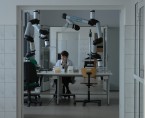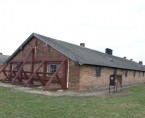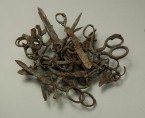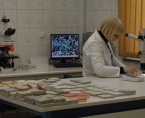Preservation
The Museum Preservation Department is responsible for protecting everything that remains at the Auschwitz-Birkenau Concentration Camp site. It has one of the most advanced conservation workshops in the world at its disposal, and employs a staff of highly qualified specialists in landmark preservation, as well as specialists in various technical fields. It monitors the condition of the objects at the site and carries out essential conservation work.
The Department plans and carries out renewal, conservation, and new investment projects. It oversees 155 buildings (including original camp blocks, barracks, and outbuildings), some 300 ruins and other vestiges of the camp—including the ruins of the four gas chambers and crematoria at the Auschwitz II-Birkenau site that are of particular historical significance—as well as more than 13 km. of fencing, 3,600 concrete fence posts, and many other installations. There are kilometers of roads, drainage ditches, railroad tracks including a spur and unloading platform, two original sewage-treatment plants, and fire-prevention reservoirs on grounds covering almost 200 hectares. The low-growing vegetation and the historical and postwar trees (including about 20 hectares of woods) also require ongoing conservation.
The Department devotes a large part of its efforts to the conservation of movable objects from the Museum collections. These include about 110 thousand shoes, about 3,800 suitcases, 12 thousand pots and pans, 40 kg. of eyeglasses, 470 prostheses, 570 items of camp clothing, as well as 4,5 thousand works of art. The Museum Archives hold documents that fill almost 250 meters of shelving, including 48 volumes of the so-called camp death books, 248 volumes of records from the Waffen-SS and Police Central Construction Board in Auschwitz, 64 volumes of records from the SS-Hygiene Institut, 16 volumes of personal files on prisoners, and about 8 thousand camp letters.
The Department uses the most advanced technical methods possible within the financial resources of the Museum. The emphasis falls on the greatest feasible preservation of extant original material, introducing the bare minimum of additional, clearly marked elements in order to rescue and interpret the original items while making them accessible to visitors. Necessary changes are introduced in such a way as to make them visible, and are always meticulously documented. Whenever possible, the Department carries out conservation work using discrete, reversible processes. This leaves the possibility open for carrying out new conservation, with more advanced techniques, in the future.
Detailed records cover all conservation work, on individual items or entire buildings. Special folders contain not only a precise photographic record of each stage of conservation work, but also a comprehensive analysis undertaken before the start of each project, an exact description of the conservation techniques applied, and documentation of the object after the completion of conservation.
The Preservation Department has two basic units: the conservation section and the construction-renovation section. We employ a total of 41 specialists in various fields:
• certified landmark preservationist experts specializing in the conservation of paper and leather, paintings, and building materials
• a specialist in the conservation of vegetation
• structural, construction, and electrical engineers
• expert artisans, including carpenters, joiners, bricklayers, painters, locksmiths, electricians, and automation specialists.



